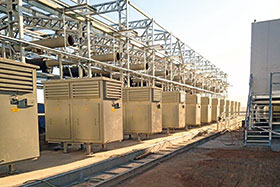Mines reduce fire hazards
August 2020
Electrical Power & Protection

Underground mines in southern, central, and west Africa have been seeing the safety benefits of dry-type transformers from Johannesburg-based Trafo Power Solutions.
According to managing director David Claassen, this clientele even includes collieries, where the strictest safety regulations apply with regard to fire hazards.
“The high risk of fire in underground coal mining environments has led to a high demand for dry-type transformers,” adds Claassen. “Among the fire risks that coal mines face are transformer short-circuits as well as fires reaching the transformer.”
He notes that dry-type transformer technology is rated Class F1 in terms of fire protection, ensuring that transformers supplied by Trafo Power Solutions are flame-retardant. “Oil-cooled transformers, on the other hand, are a fire risk due to the oil they contain to cool the windings,” he outlines. “The risk is heightened by the harsh operating conditions in which many transformers must function on mines.”
These transformers also require regular attention and maintenance. Oil samples must be taken at prescribed intervals, and these must be tested at a laboratory with the appropriate accreditation. Testing must be conducted to ensure that oil purity is within bounds, and to check for gas levels and pressure build-up in the oil tank.
“This maintenance can present challenges and added costs if the equipment is located on a remote mine far from a source of expertise and the right equipment,” explains Claassen. “With dry-type transformers, it is really only the temperature that requires monitoring. The equipment comprises limited componentry, so generally requires servicing only twice a year.”
He highlights that these regular inspections are brief and simple, taking just a couple of hours. Key aspects to be checked are the physical termination connections – which must be tightened to the right torque – and any dust that has gathered around the core and windings must be cleaned away.
Trafo Power Solutions has in recent years supplied dry-type transformers – along with ancillary power equipment such as low and medium voltage switchgear – to mines in South Africa, Mozambique, Zambia, the Democratic Republic of Congo, Ghana and Sierra Leone. In addition to coal, there are gold and base metal producers included in this clientele.
Further reading:
Hitachi Energy’s power quality solution
Electrical Power & Protection
Hitachi Energy has announced the deployment of its power quality solution to connect Tanzania’s leading gold producer, Geita Gold Mine (GGML) securely to the national grid.
Read more...
Rail electrification and EV solutions for integrated transport systems
Electrical Power & Protection
A comprehensive range of solutions for rail electrification and electric vehicles is available from leading technology provider ABB, contributing significantly to integrated and sustainable transport systems.
Read more...
PPS delivers containerised distribution board for Western Cape hybrid power project
Electrical Power & Protection
South African electrical enclosure specialist Power Process Systems has successfully completed the design, fabrication and commissioning of a 4000 A containerised distribution board for a wind/PV solar hybrid renewable energy project on a site in the Western Cape.
Read more...
The choice of a thermal carrier is critical for optimal processing
Electrical Power & Protection
Historically steam, fuelled by coal, has been the most prevalent thermal carrier in South African industry. However, times are changing, with the manufacturing and processing sector needing to review the energy reticulation systems and thermal carriers currently in use.
Read more...
ABB’s blueprint for a net zero future
Electrical Power & Protection
ABB’s Mission to Zero is a strategic initiative aimed at achieving a sustainable future characterised by zero emissions, zero accidents and zero waste.
Read more...
How South Africa’s transformer manufacturing industry can fill a gaping infrastructure gap
ACTOM Electrical Machines
Electrical Power & Protection
South Africa’s energy transition is accelerating the demand for power transformers. However, this shift toward renewable energy is exposing a critical infrastructure gap: a severe shortage of transformers.
Read more...
General-purpose 350 W AC-DC power supply
Electrical Power & Protection
The TDK-Lambda GUS350 series of compact single-output general-purpose power supplies addresses the need for an economically priced product while maintaining reliability and quality.
Read more...
Ground-breaking battery tester
Comtest
Electrical Power & Protection
Midtronics offers the proven MVT handheld battery tester. This revolutionary tool, powered by MDX-AI, is set to redefine the standards of battery diagnostics and testing in the automotive industry.
Read more...
Green hydrogen could be the missing link in powering the future of technology
Electrical Power & Protection
Green hydrogen has numerous applications across multiple industries. It also has the potential to provide a clean energy source to power future technology, with far-reaching implications for both industry and society.
Read more...
Energy audits pave the pathway to sustainability and savings
Schneider Electric South Africa
Electrical Power & Protection
Energy audits serve as essential tools for businesses looking to reduce costs and meet environmental targets. By analysing energy consumption across systems such as lighting, HVAC, ICT and water infrastructure, audits identify inefficiencies and quantify carbon footprints, enabling data-driven decisions for operational and financial optimisation.
Read more...


